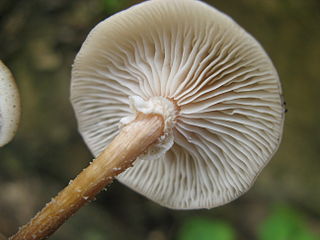
Armillaria is a genus of fungi that includes the A. mellea species known as honey fungi that live on trees and woody shrubs. It includes about 10 species formerly categorized summarily as A. mellea. Armillarias are long-lived and form the largest living fungi in the world. The largest known organism covers more than 3.4 square miles (8.8 km2) in Oregon's Malheur National Forest and is estimated to be 2,500 years old. Some species of Armillaria display bioluminescence, resulting in foxfire.
Index Fungorum is an international project to index all formal names in the fungus kingdom. As of 2015 the project is based at the Royal Botanic Gardens, Kew, one of three partners along with Landcare Research and the Institute of Microbiology, Chinese Academy of Sciences.

Rhizomorpha subcorticalis is a species name that has been used to characterize certain fungal plant pathogen observations where the pathogen is evident only through mycelial cords ("rhizomorphs"). The species in question very likely also produces reproductive structures which would allow it to be situated in the normal taxonomic tree, especially if DNA analysis is available. A name like R. subcorticalis should only be used where such identification is impossible.

Armillaria gallica is a species of honey mushroom in the family Physalacriaceae of the order Agaricales. The species is a common and ecologically important wood-decay fungus that can live as a saprobe, or as an opportunistic parasite in weakened tree hosts to cause root or butt rot. It is found in temperate regions of Asia, North America, and Europe. The species forms fruit bodies singly or in groups in soil or rotting wood. The fungus has been inadvertently introduced to South Africa. Armillaria gallica has had a confusing taxonomy, due in part to historical difficulties encountered in distinguishing between similar Armillaria species. The fungus received international attention in the early 1990s when an individual colony living in a Michigan forest was reported to cover an area of 15 hectares, weigh at least 9.5 tonnes, and be 1,500 years old. This individual is popularly known as the "humongous fungus", and is a tourist attraction and inspiration for an annual mushroom-themed festival in Crystal Falls. Recent studies have revised the fungus's age to 2,500 years and its size to about 400 tonnes, four times the original estimate.
Armillaria affinis is a species of agaric fungus in the family Physalacriaceae. This species is found in Central America.
Armillaria camerunensis is a species of agaric fungus in the family Physalacriaceae. This species is found in Africa.
Armillaria duplicata is a species of mushroom in the family Physalacriaceae. This species is found in Asia.
Armillaria melleorubens is a species of mushroom in the family Physalacriaceae. This species is found in Central America.
Armillaria montagnei is a species of agaric fungus in the family Physalacriaceae. This species is found in Australia, Europe, New Zealand, and South America.
Armillaria omnituens is a species of mushroom in the family Physalacriaceae. This species is found in Asia.
Armillaria pallidula is a species of mushroom in the family Physalacriaceae. This species is found in Australia.
Armillaria pelliculata is a species of agaric fungus in the family Physalacriaceae. This species is found in Africa.
Armillaria procera is a species of agaric fungus in the family Physalacriaceae. This species is found in South America.
Armillaria tigrensis is a species of mushroom in the family Physalacriaceae. This species is found in South America.

Armillaria puiggarii is a species of agaric fungus in the family Physalacriaceae. This species is found in Central and South America.

Armillaria ostoyae is a species of fungus (mushroom), pathogenic to trees, in the family Physalacriaceae. In the western United States, it is the most common variant of the group of species under the name Armillaria mellea. A. ostoyae is common on both hardwood and conifer wood in forests west of the Cascade Range in Oregon, United States. It has decurrent gills and the stipe has a ring. The mycelium invades the sapwood and is able to disseminate over great distances under the bark or between trees in the form of black rhizomorphs ("shoestrings"). In most areas of North America, Armillaria ostoyae can be separated from other species by its physical features: cream-brown colors, prominent cap scales, and a well-developed stem ring distinguish it from other Armillaria. Like several other Armillaria, the mycelium of Armillaria ostoyae can display bioluminescence, resulting in foxfire.
Roy Watling, PhD., DSc, FRSE, F.I.Biol., C.Biol., FLS is a Scottish mycologist who has made significant contributions to the study of fungi both in the identification of new species and correct taxonomic placement, as well as in fungal ecology.

Rhizomorpha is a genus of fungi that was created for species known only by their mycelial cords ("rhizomorphs") and so impossible to classify within the normal taxonomic system, which is based on reproductive structures.





